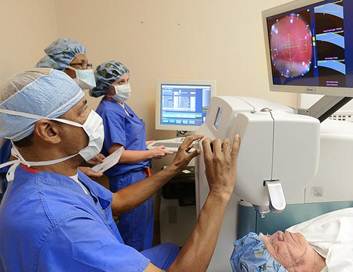North Carolina Eye, Ear, Nose & Throat Offers New Laser Cataract Procedure

North Carolina Eye, Ear, Nose & Throat (NCEENT) is the first eye surgery center in the Triangle to offer “bladeless” cataract surgery with the LenSx Laser. The most scientifically advanced technology available. Indeed, NCEENT specialist in cataract and refractive surgery Dwight Perry, M.D., is already up-to-speed and performing the new procedure. (See figure right; image source:http://www.heraldsun.com/news/showcase/x249848879/New-laser-procedure-offered-locally-for-cataract-surgery-patients.)
As with the advent of LASIK and then the advancement of Intralase technology, cataract surgery can now be performed blade-free. The new, state-of-the-art advantage of the LenSx system is that, for the cataract procedure, it uses a laser instead of a blade to make incisions on the eye.
With cataract surgery being even more common that LASIK, the use of the LenSx system will soon become the standard for performing cataract procedures, much as the excimer and Intralase lasers used in LASIK have become the nonpareil technologies in refractive laser-vision correction.
One of Dr. Perry’s landmark first LenSx procedures provided more than successful results for his patient. The situation was ideal for comparing a cataract procedure performed with a blade and one with the LenSx laser. The patient had already had cataract surgery done on one eye only with the old technology. Later, the same patient had cataract surgery on the other eye done with the LenSx laser. The result was the patient’s eye that underwent the procedure with the laser was healing faster than the other eye had, and the patient’s vision in the laser-treated eye was much crisper. So these are the general expectations and results using the LenSx laser for the cataract procedure: shorter healing time and better vision sooner.
Another interesting parallel with LASIK is that both the LenSx and the Intralase use femtosecond laser technology. First with LASIK, and now with cataract surgery, patients are able to choose between a metal blade and a laser for their vision-correction procedures. And ultimately, as it always should be with any new technology or procedure, the advantage and benefit must be for the patient!



